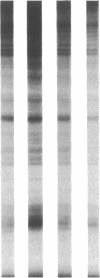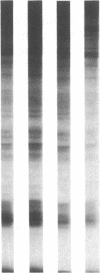Abstract
Mechanisms responsible for broad-based resistance to antitumor drugs derived from natural products (multidrug resistance) are incompletely understood. Agents known to reverse the multidrug-resistant phenotype (verapamil and trifluoperazine) can also inhibit the activity of protein kinase C. When we assayed human breast cancer cell lines for protein kinase C activity, we found that enzyme activity was 7-fold higher in the multidrug-resistant cancer cells compared with the control, sensitive parent cells. Exposure of drug-sensitive cells to the phorbol ester phorbol 12,13-dibutyrate [P(BtO)2] led to an increase in protein kinase C activity and induced a drug-resistance phenotype, whereas exposure of drug-resistant cells to P(BtO)2 further increased drug resistance. In sensitive cells, this increased resistance was accompanied by a 3.5-fold increased phosphorylation of a 20-kDa particulate protein and a 35-40% decreased intracellular accumulation of doxorubicin and vincristine. P(BtO)2 induced resistance to agents involved in the multidrug-resistant phenotype (doxorubicin and vincristine) but did not affect sensitivity to an unrelated alkylating agent (melphalan). The increased resistance was partially or fully reversible by the calcium channel blocker verapamil and by the calmodulin-antagonist trifluoperazine. These data suggest that stimulation of protein kinase C plays a role in the drug-transport changes in multidrug-resistant cells. This may occur through modulation of an efflux pump by protein phosphorylation.
Full text
PDF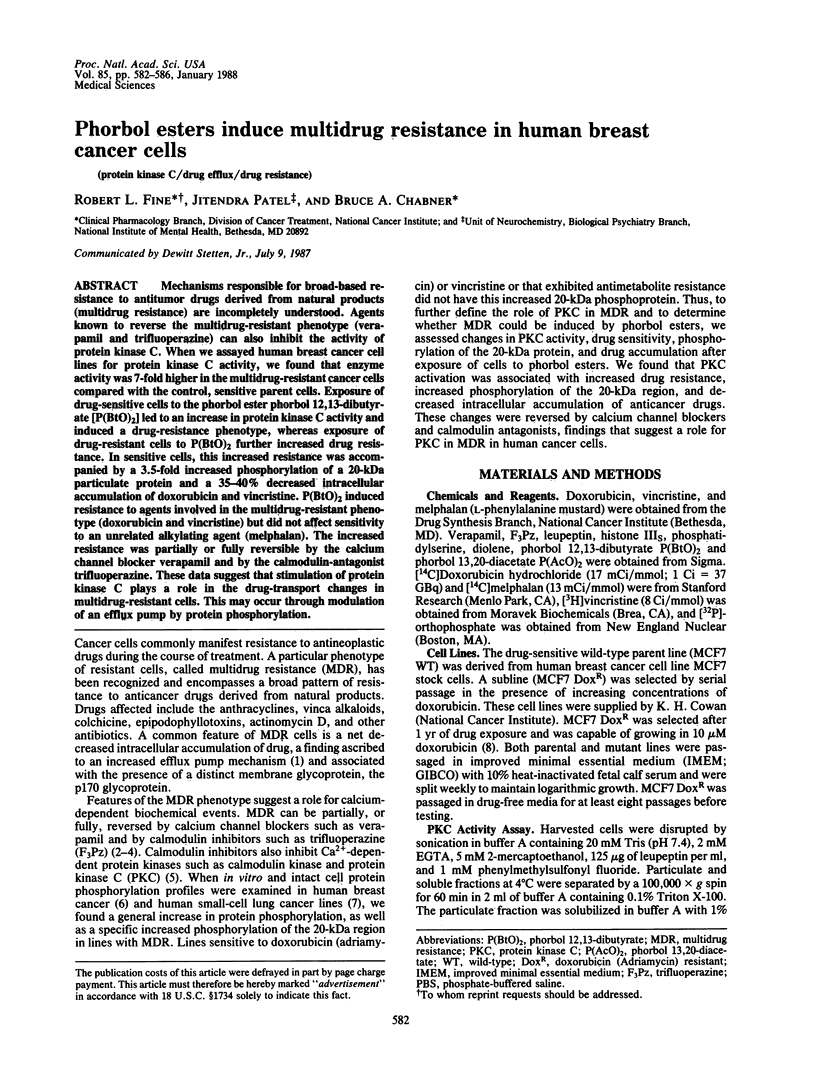
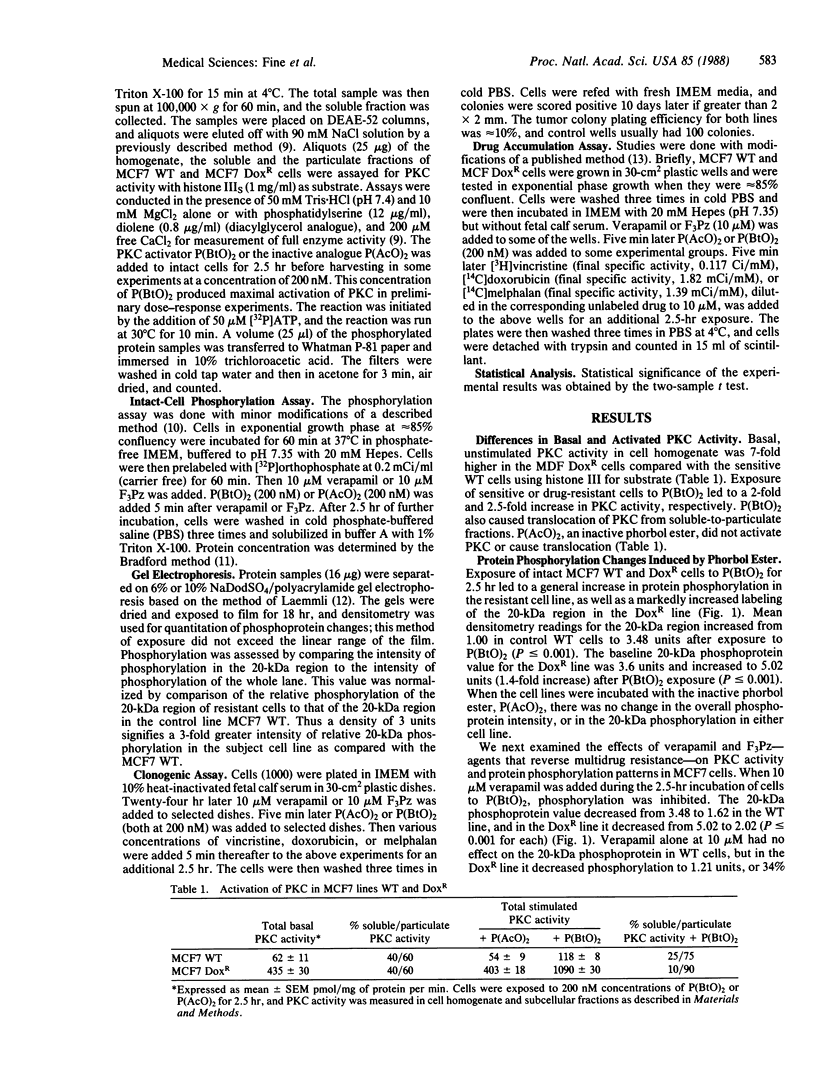
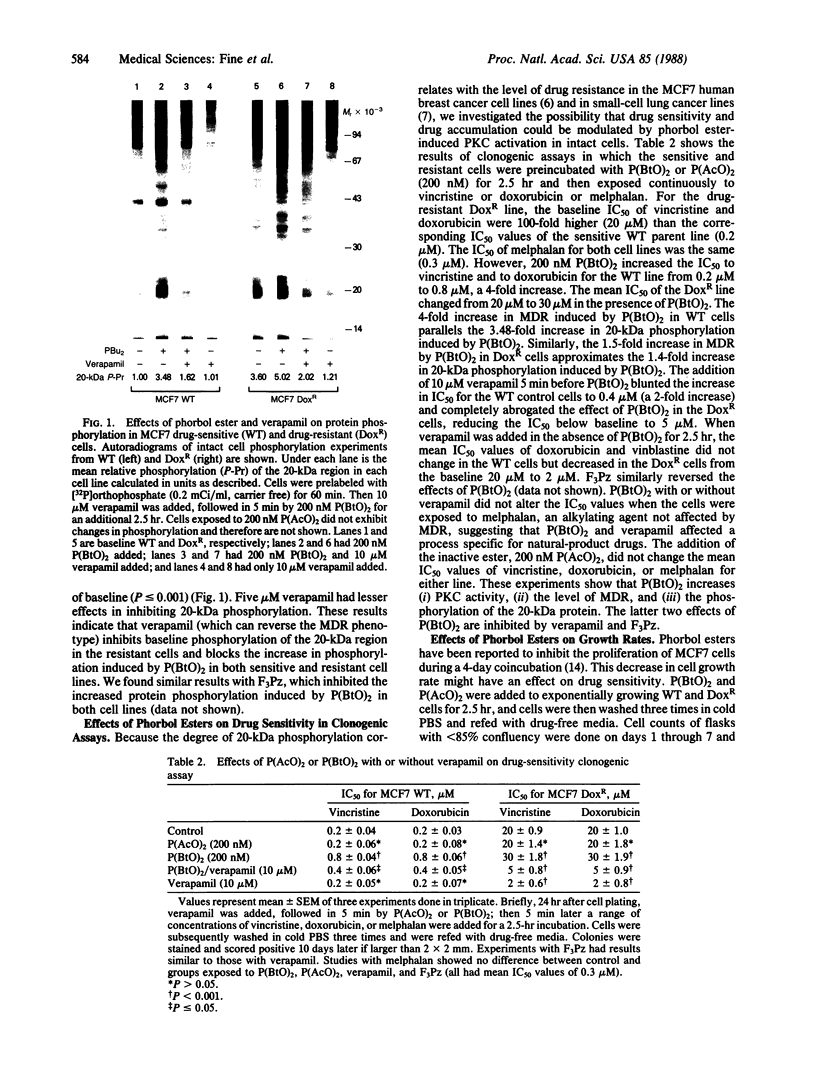
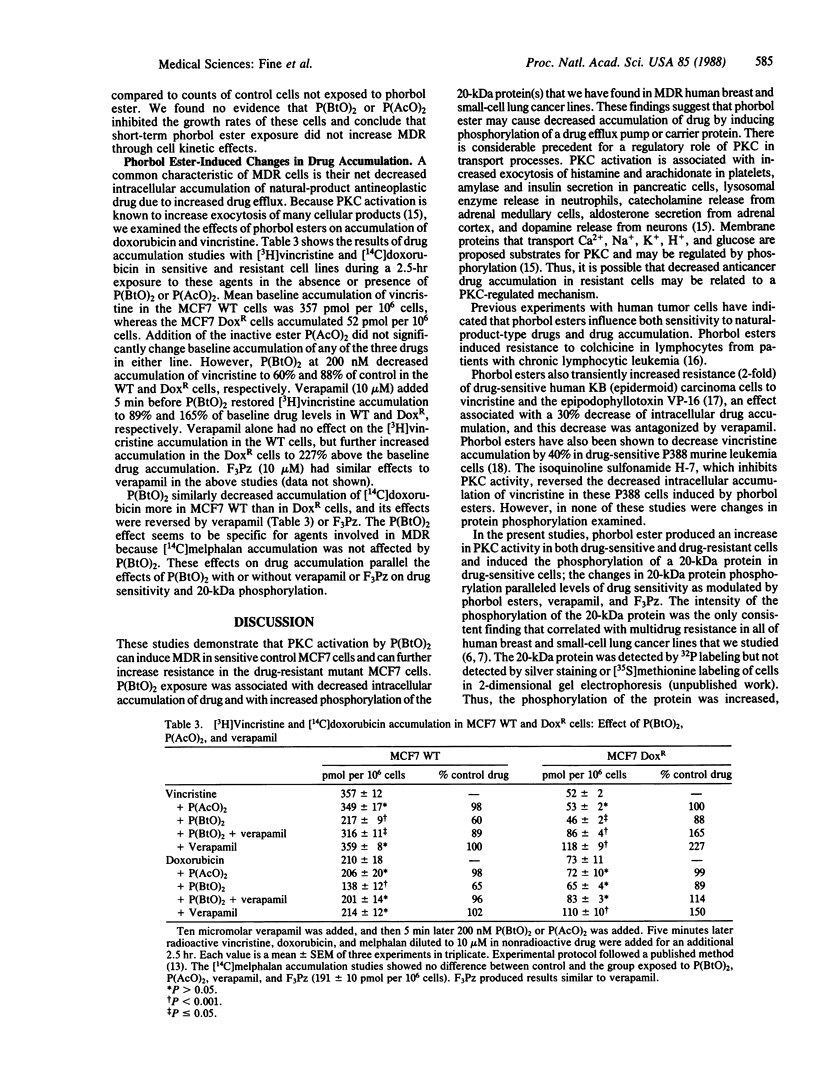
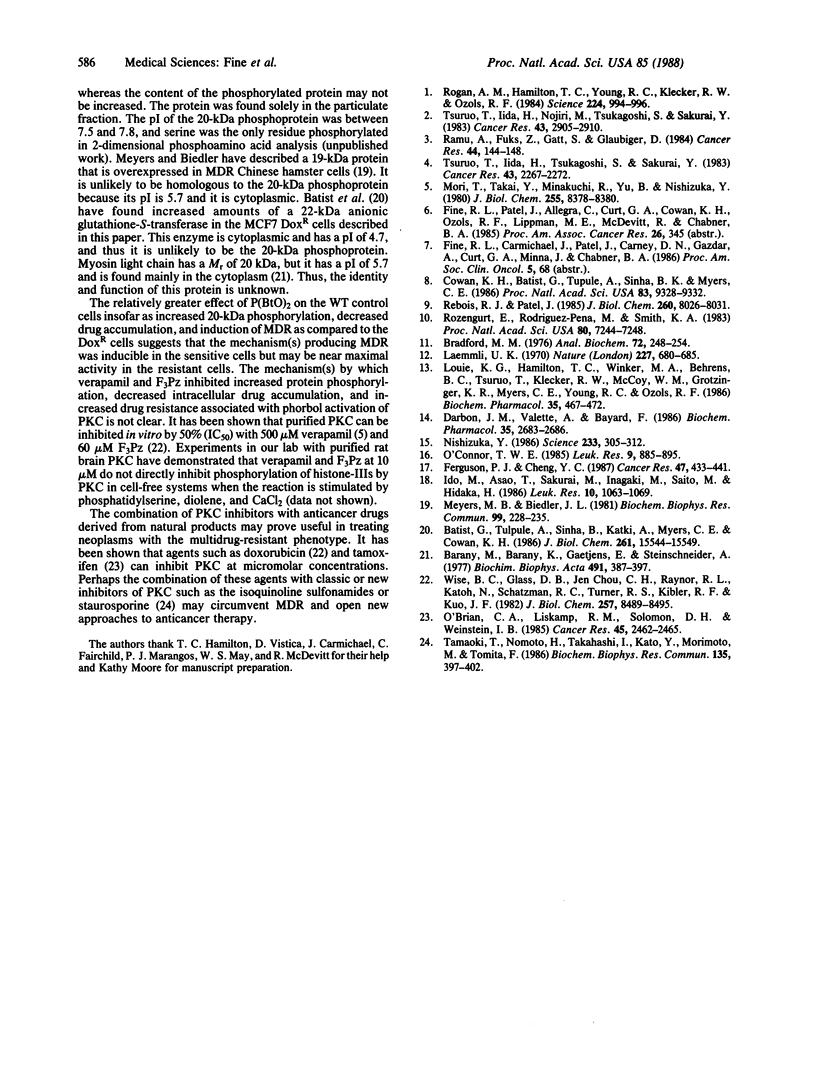
Images in this article
Selected References
These references are in PubMed. This may not be the complete list of references from this article.
- Batist G., Tulpule A., Sinha B. K., Katki A. G., Myers C. E., Cowan K. H. Overexpression of a novel anionic glutathione transferase in multidrug-resistant human breast cancer cells. J Biol Chem. 1986 Nov 25;261(33):15544–15549. [PubMed] [Google Scholar]
- Bradford M. M. A rapid and sensitive method for the quantitation of microgram quantities of protein utilizing the principle of protein-dye binding. Anal Biochem. 1976 May 7;72:248–254. doi: 10.1006/abio.1976.9999. [DOI] [PubMed] [Google Scholar]
- Bárány M., Bárány K., Gaetjens E., Steinschneider A. Isolation of phosphorylated acid chloroform/methanol-soluble proteins from live frog muscle. Biochim Biophys Acta. 1977 Apr 25;491(2):387–397. doi: 10.1016/0005-2795(77)90281-1. [DOI] [PubMed] [Google Scholar]
- Cowan K. H., Batist G., Tulpule A., Sinha B. K., Myers C. E. Similar biochemical changes associated with multidrug resistance in human breast cancer cells and carcinogen-induced resistance to xenobiotics in rats. Proc Natl Acad Sci U S A. 1986 Dec;83(24):9328–9332. doi: 10.1073/pnas.83.24.9328. [DOI] [PMC free article] [PubMed] [Google Scholar]
- Darbon J. M., Valette A., Bayard F. Phorbol esters inhibit the proliferation of MCF-7 cells. Possible implication of protein kinase C. Biochem Pharmacol. 1986 Aug 15;35(16):2683–2686. doi: 10.1016/0006-2952(86)90175-9. [DOI] [PubMed] [Google Scholar]
- Ferguson P. J., Cheng Y. C. Transient protection of cultured human cells against antitumor agents by 12-O-tetradecanoylphorbol-13-acetate. Cancer Res. 1987 Jan 15;47(2):433–441. [PubMed] [Google Scholar]
- Ido M., Asao T., Sakurai M., Inagaki M., Saito M., Hidaka H. An inhibitor of protein kinase C, 1-(5-isoquinolinylsulfonyl)-2-methylpiperazine(H-7) inhibits TPA-induced reduction of vincristine uptake from P388 murine leukemic cell. Leuk Res. 1986;10(9):1063–1069. doi: 10.1016/0145-2126(86)90050-0. [DOI] [PubMed] [Google Scholar]
- Laemmli U. K. Cleavage of structural proteins during the assembly of the head of bacteriophage T4. Nature. 1970 Aug 15;227(5259):680–685. doi: 10.1038/227680a0. [DOI] [PubMed] [Google Scholar]
- Louie K. G., Hamilton T. C., Winker M. A., Behrens B. C., Tsuruo T., Klecker R. W., Jr, McKoy W. M., Grotzinger K. R., Myers C. E., Young R. C. Adriamycin accumulation and metabolism in adriamycin-sensitive and -resistant human ovarian cancer cell lines. Biochem Pharmacol. 1986 Feb 1;35(3):467–472. doi: 10.1016/0006-2952(86)90221-2. [DOI] [PubMed] [Google Scholar]
- Meyers M. B., Biedler J. L. Increased synthesis of a low molecular weight protein in vincristine-resistant cells. Biochem Biophys Res Commun. 1981 Mar 16;99(1):228–235. doi: 10.1016/0006-291x(81)91736-8. [DOI] [PubMed] [Google Scholar]
- Mori T., Takai Y., Minakuchi R., Yu B., Nishizuka Y. Inhibitory action of chlorpromazine, dibucaine, and other phospholipid-interacting drugs on calcium-activated, phospholipid-dependent protein kinase. J Biol Chem. 1980 Sep 25;255(18):8378–8380. [PubMed] [Google Scholar]
- Nishizuka Y. Studies and perspectives of protein kinase C. Science. 1986 Jul 18;233(4761):305–312. doi: 10.1126/science.3014651. [DOI] [PubMed] [Google Scholar]
- O'Brian C. A., Liskamp R. M., Solomon D. H., Weinstein I. B. Inhibition of protein kinase C by tamoxifen. Cancer Res. 1985 Jun;45(6):2462–2465. [PubMed] [Google Scholar]
- O'Connor T. W. Phorbol ester-induced loss of colchicine ultrasensitivity in chronic lymphocytic leukaemia lymphocytes. Leuk Res. 1985;9(7):885–895. doi: 10.1016/0145-2126(85)90310-8. [DOI] [PubMed] [Google Scholar]
- Ramu A., Fuks Z., Gatt S., Glaubiger D. Reversal of acquired resistance to doxorubicin in P388 murine leukemia cells by perhexiline maleate. Cancer Res. 1984 Jan;44(1):144–148. [PubMed] [Google Scholar]
- Rebois R. V., Patel J. Phorbol ester causes desensitization of gonadotropin-responsive adenylate cyclase in a murine Leydig tumor cell line. J Biol Chem. 1985 Jul 5;260(13):8026–8031. [PubMed] [Google Scholar]
- Rogan A. M., Hamilton T. C., Young R. C., Klecker R. W., Jr, Ozols R. F. Reversal of adriamycin resistance by verapamil in human ovarian cancer. Science. 1984 Jun 1;224(4652):994–996. doi: 10.1126/science.6372095. [DOI] [PubMed] [Google Scholar]
- Rozengurt E., Rodriguez-Pena M., Smith K. A. Phorbol esters, phospholipase C, and growth factors rapidly stimulate the phosphorylation of a Mr 80,000 protein in intact quiescent 3T3 cells. Proc Natl Acad Sci U S A. 1983 Dec;80(23):7244–7248. doi: 10.1073/pnas.80.23.7244. [DOI] [PMC free article] [PubMed] [Google Scholar]
- Tamaoki T., Nomoto H., Takahashi I., Kato Y., Morimoto M., Tomita F. Staurosporine, a potent inhibitor of phospholipid/Ca++dependent protein kinase. Biochem Biophys Res Commun. 1986 Mar 13;135(2):397–402. doi: 10.1016/0006-291x(86)90008-2. [DOI] [PubMed] [Google Scholar]
- Tsuruo T., Iida H., Nojiri M., Tsukagoshi S., Sakurai Y. Circumvention of vincristine and Adriamycin resistance in vitro and in vivo by calcium influx blockers. Cancer Res. 1983 Jun;43(6):2905–2910. [PubMed] [Google Scholar]
- Tsuruo T., Iida H., Tsukagoshi S., Sakurai Y. Potentiation of vincristine and Adriamycin effects in human hemopoietic tumor cell lines by calcium antagonists and calmodulin inhibitors. Cancer Res. 1983 May;43(5):2267–2272. [PubMed] [Google Scholar]
- Wise B. C., Glass D. B., Chou C. H., Raynor R. L., Katoh N., Schatzman R. C., Turner R. S., Kibler R. F., Kuo J. F. Phospholipid-sensitive Ca2+-dependent protein kinase from heart. II. Substrate specificity and inhibition by various agents. J Biol Chem. 1982 Jul 25;257(14):8489–8495. [PubMed] [Google Scholar]



